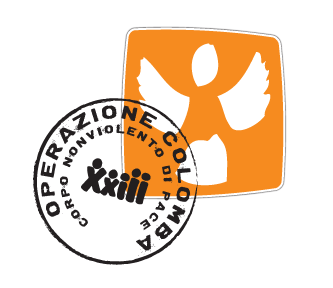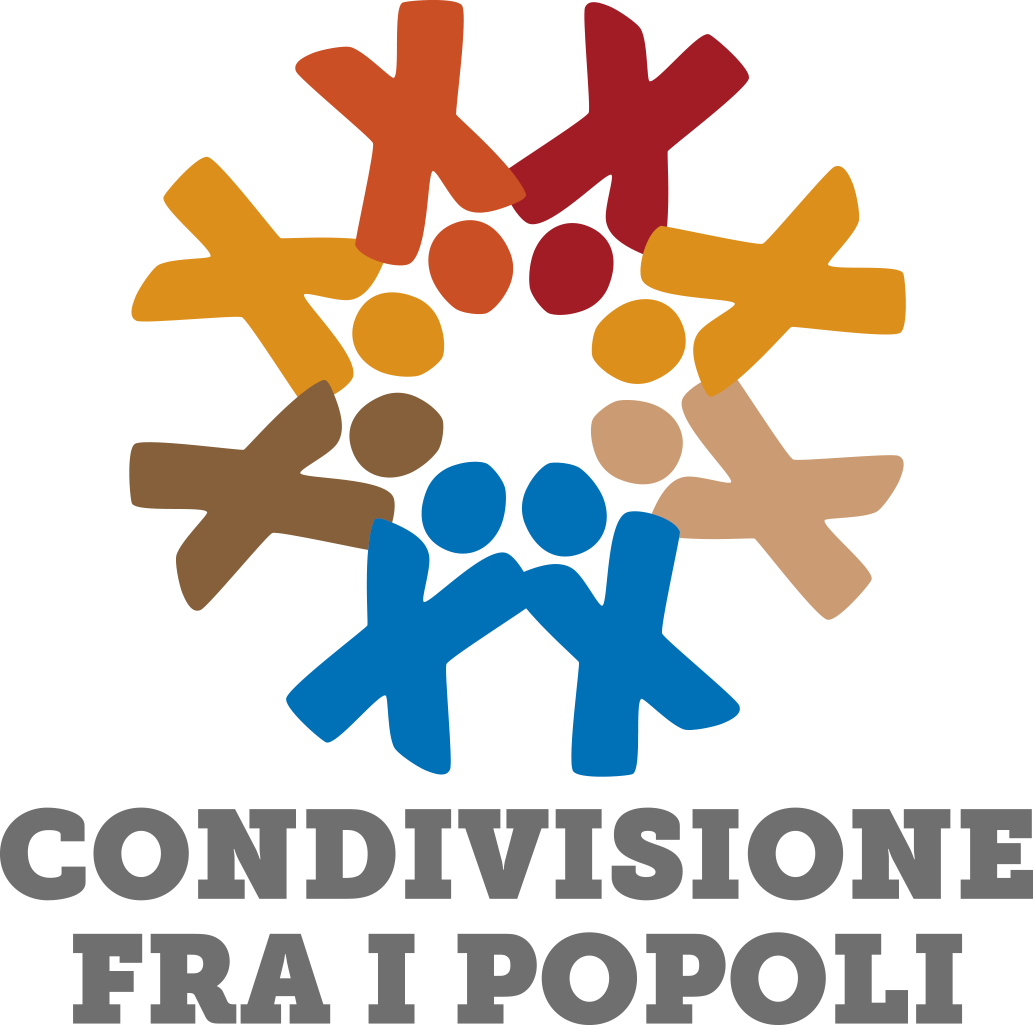"Hacer memoria es un compromiso por el futuro".
(Remembering is a commitment for future)
This sentence can accurately sum up the intense days we lived among the Peace Community of San José de Apartadó, Colombia, during the commemoration of the killings of Mulatos and Resbalosa, which took place on February 21st, 2005. Since then, the Community gathers every year to engage in an active and vivid remembrance, so fundamentally essential for their nonviolent resistance.
From the very first hours of the early morning in La Holandita, on February 19th, one could already hear some voices attending the preparations of the first of four days dedicated to hacer memoria of Luis Eduardo, Bellanira, Deiner, Alfonso, Sandra, Santiago, Natalia and Alejandro. Luis Eduardo’s son, Sebastián, who was two years old at the time of the killings, climbs up the Community’s main gate to hang up, with extreme care, a banner reading: “WE RESIST FOR LIFE, FIGHT FOR JUSTICE AND WALK FOR DIGNITY”.
Little by little, Community members greet the arrivals of visitors coming from several parts of the country or the world in order to walk by their side during these days: networks of solidarity, former volunteers from international accompaniment groups, university students or simply friends who met this group of farmers in recent years, acknowledging the ethical significance of their journey. Eventually, some representatives of the British and German embassies also join us, alongside a delegation from the 2nd United Nations Verification Mission.
The Community and its guests all come together in the kiosk prepared for this event. The first greetings are delivered by Germán Graciano, the legal representative of the Peace Community, who names, one by one, all the people present. Then, Father Javier recalls the path followed by the Community since its birth. Lawyer Germán Romero also explains, meticulously, the latest developments of the pending legal procedure, highlighting once again that the killings were not a military operation, but rather an act of persecution clearly defined.
Germán recalls that “(…) there are some painful, extremely painful details about what happened. Young Natalia and her father Alfonso understood what was to come. Natalia, trying to calm down her brother Santiago, takes a little backpack and fills it with clothes, telling him they would be leaving for a trip. She then entrusts the bag to him, hoping to reassure him, just before they were separated from their parents and got their throats slit. A five-year-old child and an eighteen-month-old infant. All this happened in front of the military (...)”.
The following speeches are delivered by the diplomats, assuring their solidarity and support, just as the various international accompaniment groups and all the national and international delegations. Time however is running out, since the day’s program also features the march to San José.
The children all round up next to the Cacao workshop, while the whole Community and its new and older friends stand behind them. Many, countless, colorful posters are firmly held by people: Los niños y niñas pedimos justicia por Deiner 11 años, Natalia 5 años y Santiago 18 meses (We, children, ask for justice for Deiner, 11 years old, Natalia, 5 years old and Santiago, 18 months old); Los niños decimos NO a la explotación minera (We, children, say NO to mining); Respetemos nuestra cordillera, bosques y ríos (Let’s respect our cordillera, forests and rivers).
Once in San José, the small village in which the Peace Community was born in 1997, another remembrance act takes place. A funeral march is played, before the children from the Peace Community of José Luis Perales sing Que canten los niños (Let the children sing). Strong emotions are shared while the other children of San José, on their way back from school, come around the choir and stay until the act is over.

Back in La Holandita, lunch allowed for true moments of sharing. The embassies were given many thanks for their meaningful presence on this special day. Tirelessly, preparations however resumed: the next day was indeed to be the first of a three-day march of remembrance. With an endless row of mules and horses, the Community reached the Aldea de paz Luis Eduardo Guerra, in the village of Mulatos Medio. The journey took almost six hours across the mountains of the Serranía de Abibe, during which those who ventured into the Colombian jungle for the first time had the chance to admire the wonders of these lands: blue butterflies, flowers, palm trees, bolanderas, huge nests hanging from the trees and the plentiful sounds of nature.
Midway, the column stops to rest a while, especially for mothers carrying infants in shifts with fathers and uncles. Either by mule or by foot, what matters is to take the path. Regardless of the age, because “hacer memoria es un compromiso por el futuro”. Rest is also needed for the international friends and visitors, who are not used to walking in the moist heat of this land, let alone to be seated for long hours on a mule.
We get to the Aldea de Paz. A strong energy is displayed by most of us, in spite of the tiredness and the grave motives explaining our presence there. So many colors, green, blue, yellow. Children running, farmers unloading the mules’ shipment, some go down to the river to bathe for a brief moment, others install hammocks under local monitoring.

These farmers are always there, ready to help, expressing gratitude and highlighting the great value of our presence. We answer by being always there, ready to help, expressing gratitude and highlighting the great value of their resistance.
Around nightfall the line for dinner forms: rice and beans for everyone. The meal is savored on the logs intended for the fire. Little by little, people started withdrawing, some to the kiosk, some into a house, others into a drying room or the community library. Lights turn off and hammocks provide rest.
On the next morning, at 7:30, the exact time when Luis Eduardo Guerra, Bellanira and Deiner were murdered, the Holy Mass begins, celebrated by Father Javier. Only a few days before, thanks to an incredible Community work, we had witnessed the completion of the small dome crowning the stone chapel erected where the bodies were found. The Community gathers and communes around the little chapel. Luis Eduardo’s and Deiner’s family sits there, united, having opened the door that held their pain. They have been able to transform all this suffering into hope and strength to keep on fighting in the wake of their uncle, father, brother.
Before that cross, today, people look down while their thoughts fly over that dome, remembering he who was, and still is, a great leader for this Community. All hats are removed and left on the ground. Seeing the children, seated in the front rows and wearing the t-shirt specially made for this occasion, bend their heads may be the most moving vision. Father Javier has some words of prophet Isaiah be read, particularly chapter 53, which remarkably describes Luis Eduardo’s life and death.
“(…) He was oppressed and afflicted,
yet he did not open his mouth;
he was led like a lamb to the slaughter,
and as a sheep before its shearers is silent,
so he did not open his mouth.
By oppression and judgment he was taken away.
Yet who of his generation protested?
For he was cut off from the land of the living;
for the transgression of my people he was punished (...)”

Legacy lives within the sacredness of this ground, where the blood of Luis Eduardo, Bellanira and Deiner was shed. Luis Eduardo’s life has indeed deeply influenced the Community. Although he had not studied, he was a self-taught mind, always reading, reflecting and crafting thoughts. Therefore, during the complex and dark moments the Community had to go through from the beginning, a usual resource was asking Luis Eduardo which way to go. He always came up with an answer and a manner to solve complicated situations. He was a guide. Remembering him thus came to be a genuine part of the Community’s narrative and a way of keeping its initial ideals alive.
Once the ceremony was over, line formed again for lunch: lentils, salad and rice. While people finished eating, others prepared the mules for the next step on this path of remembrance, namely, a one-hour uphill walk to reach the village of Resbalosa where, around midday on February 21st, 2005, Alfonso, Sandra, Natalia, Santiago and Alejandro – a working man who was not part of the Peace Community – were murdered.

In front of the distinct remains of the two ditches where their dismembered bodies were found, we read an old Gujarati hymn that Gandhi asked to listen on his last day. Here too, the memories of the victims were turned into a small chapel, housing a cacao tree, witness of that day’s horror.
“Whether weary or unweary, O Man,
do not tarry,
Stop not, your struggle if single-handed,
Continue, and do not tarry.
The paths that you’ll cross
Will be wilder and confuse,
The lives that you’ll save
Will be pitiable and mute.
Lose not, your confidence, O Man,
Do not tarry.
The life that you’ll live
Will exhaust and enrage,
Growing difficulties
Will continually frustrate.
But bearing these burdens all, O Man,
Do not tarry.
Jump over your troubles
That are big like mountains.
Behind whom are fields
That are dried up and barren.
Yet try and till that land, O Man,
Do not tarry.
The world will be dark
You shall enlighten it,
All around will be blackness
You shall erase it.
And even if Life deserts you then, O Man,
Do not tarry.
Never stop to take rest, O Man,
Ever strive to give rest, O Man,
And do not tarry.”

Robert, an international volunteer who accompanied the Community in search of the bodies, gives his testimony. A raw one, with numerous and most precise details. Under the shadow of the trees, the flow of tears needed to be released. Embraces of solidarity then happened while the children started singing: “Que canten los niños, que alcen la voz, que hagan al mundo escuchar... que canten por esos que no cantarán porque han apagado su voz (Let the children sing, let them raise their voice, making the world listen… Let them sing for those who cannot because their voices were silenced)”.
Emotion fills the faces of Germán and Gildardo, the leader of this Community. Luis Eduardo’s nephew, Morelis, holds his head in his hands. Brigida keeps sobbing, she who made it up here in spite of her physical condition. The infants lie in a large leaf, allowing some relief to those who carried them in their arms through the peaks of these mountains. And we, international volunteers, by them, wondering how such human misery can ever actually happen.

We resume the path to return to the Aldea de Paz. Lunch, then dinner. Seated around a fire, Bladimir grabs his guitar and sings some of his own compositions. There is peace, smiles. Will to keep fighting. Beyond us, darkness and silence.
We are there, with them, around that light, listening to these songs.
Silvia


 OPERAZIONE COLOMBA
OPERAZIONE COLOMBA
